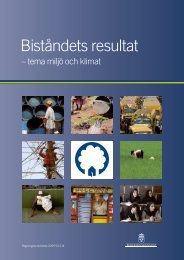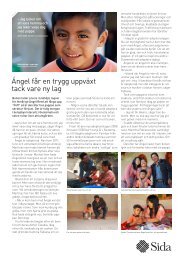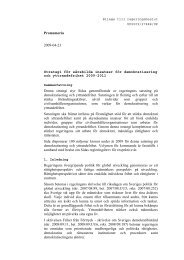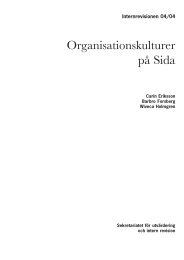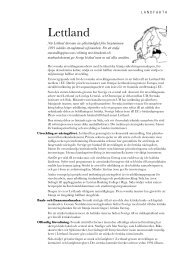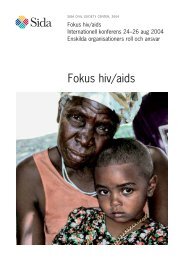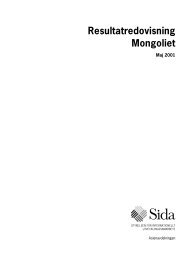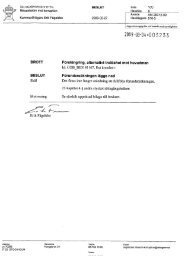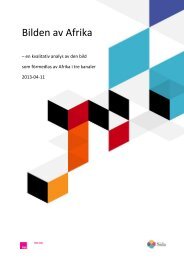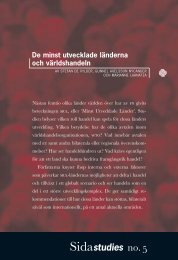Mid-Term Review of the AGIR Programme - Sida
Mid-Term Review of the AGIR Programme - Sida
Mid-Term Review of the AGIR Programme - Sida
Create successful ePaper yourself
Turn your PDF publications into a flip-book with our unique Google optimized e-Paper software.
2 F I N D I N G S<br />
to understanding sub-programmes results than to contributing to <strong>the</strong> overall programme,<br />
since <strong>the</strong> linkage between partner and intermediary has been much stronger<br />
than <strong>the</strong> linkages with o<strong>the</strong>r partners across <strong>the</strong> four sub-programmes (see <strong>AGIR</strong><br />
Semi-Annual Joint Report, 2011, page 15).<br />
Despite a widespread approval <strong>of</strong> <strong>the</strong> RBM training and <strong>the</strong> acknowledgement <strong>of</strong> its<br />
relevance at all levels <strong>of</strong> project cycle management, <strong>the</strong> intermediaries have noted <strong>the</strong><br />
difficulties experienced by partners in <strong>the</strong> shift from a Logical Framework (LFA)<br />
approach to a results-based monitoring approach. For example, Diakonia acknowledges<br />
<strong>the</strong> fact that most <strong>of</strong> <strong>the</strong>ir CSO partners’ strategic plans contained results and<br />
indicators being still designed outside <strong>of</strong> <strong>the</strong> programme results-based framework (see<br />
page 10) as one <strong>of</strong> <strong>the</strong> risks <strong>of</strong> implementing <strong>the</strong> 2012 plan. Moreover, most <strong>of</strong> <strong>the</strong><br />
partners acknowledge <strong>the</strong> capacity constraints <strong>the</strong>y face in monitoring, and suggestions<br />
<strong>of</strong> fur<strong>the</strong>r training in <strong>the</strong>se areas have been frequent among <strong>the</strong> interviewed<br />
partners.<br />
In some cases difficulties and challenges <strong>of</strong> impact monitoring and reporting stem<br />
from <strong>the</strong> nature <strong>of</strong> <strong>the</strong> activities being implemented by <strong>the</strong> partners, as well as <strong>the</strong><br />
organisational format. For example, reporting impact on advocacy is considered a<br />
challenge, since organisations do a lot <strong>of</strong> advocacy work at all levels that achieves<br />
considerable results, but is not reported (Interview with Rede da Criança). Reporting<br />
on <strong>the</strong>se results has been deficient due to a lack <strong>of</strong> capacity, as well as <strong>the</strong> very real<br />
difficulties in collecting evidence and attributing results to advocacy work which is<br />
about social change. The monitoring and reporting on outcomes associated with networks<br />
is equally difficult. For example, Rede da Criança comprises more than 140<br />
organisations with different capacities and organisational cultures; some <strong>of</strong> <strong>the</strong>m perform<br />
effective advocacy work that is not well reported. According to <strong>the</strong> IBIS 2012<br />
Annual Plan, organisations still need to adopt monitoring and evaluation practices as<br />
part <strong>of</strong> <strong>the</strong>ir current management systems to better inform <strong>the</strong>ir decisions. In <strong>the</strong>ory,<br />
<strong>the</strong> combination <strong>of</strong> partners’ reporting, field monitoring and capacity development in<br />
results-based management is a consistent approach to improve impact reporting.<br />
None<strong>the</strong>less, organisations are still struggling to adopt this approach in <strong>the</strong> full management<br />
cycle and need considerably more training to achieve <strong>the</strong> level <strong>of</strong> capacity<br />
needed to achieve operational status.<br />
Reporting on outcomes at all levels within <strong>the</strong> <strong>AGIR</strong> programme varies, but has been<br />
improving with support from <strong>the</strong> intermediaries. As an example, Diakonia works<br />
with partners to build <strong>the</strong> narrative to establish <strong>the</strong> linkages between interventions and<br />
results. Similarly Oxfam, from <strong>the</strong> beginning <strong>of</strong> <strong>the</strong> programme, has been concerned<br />
with building a narrative <strong>of</strong> how outputs lead to outcomes and acknowledging <strong>the</strong><br />
difficulties <strong>of</strong> attributing some results to <strong>the</strong> direct intervention <strong>of</strong> <strong>the</strong> programme.<br />
Generally, however, all intermediaries claim that partners’ reporting is weak and<br />
tends to be activity-focused, hence challenging <strong>the</strong> reporting on outcomes. Training<br />
has been provided in this area, but it is still among <strong>the</strong> weakest <strong>of</strong> <strong>the</strong> skills held by<br />
CSO partners.<br />
52




